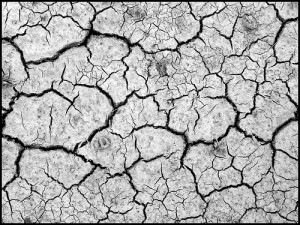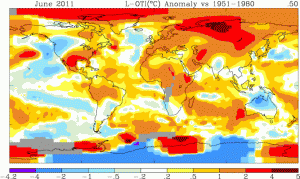
Snowpocalypse. We all remember the fun that popular media outlets like Fox News had with that one. The U.S. experienced a few weeks of anomalously cold temperatures and suddenly pundits and flapping heads were declaring the end of global warming. Yeah, that was fun. Good times.
Where are the flapping heads now? This summer has seen anomalously HIGH temperatures in the U.S. The heat wave currently striking much of the nation [1] has generated health headlines, but few itchy-trigger-finger cries about how the pundits were all wrong in the Winter and global warming is really real. It’s an excellent example of cherry picking data; that practice is a clear sign of a poor understanding of science. Snowpocalypse fit a comfortable narrative, in which climate change is a hoax and so can be easily dismissed. Our present triple digit temperatures don’t fit that narrative; those same people seem to have lost their high-paid voices.
The failure of popular media to provide good reporting on science is a failure of our community to train and educate, so that one is on us. That said, it’s never too late to do a better job. It’s bad science to cherry pick hot temperatures as evidence of global warming, just as it’s bad science to cherry pick cold ones as evidence against it. In reality, the evidence that global climate change is happening is a 150-year march of average global surface and atmospheric temperatures up, up, and up. Local anomalies are inevitable, and should not be read into too deeply. But we can use this moment of scorching temperatures to ask how widespread the heatwave actually is.
Right now, in the Northern Hemisphere, it is summer, while in the Southern Hemisphere it is Winter. This is because of the tilt of the earth, at this part of our orbit, the Northern Hemisphere is tilted toward the sun and the Southern Hemisphere is tilted away; in 6 months, the opposite will be true when we are on the other side of the sun.
We can revisit the excellent NASA website that shows you current monthly average temperatures versus averages for the same region from 1951-1980 (or any other period you like) [2]. I generated another map based on the NASA GISS data (see below).

The anomalously high temperatures began in late May for the Southwest and continued through June, spreading to other parts of the U.S. But we also see that June was anomalously hot for all of Europe, Russia, and Asia (anywhere from 0.5-5 degrees Celcius too high). Nearly all of the lower 48 of the U.S., excluding the Pacific Northwest, experienced temperatures that were 1-4 degrees Celcius hotter than the average from 1951-1980. What’s more interesting is the Southern Hemisphere, where most of South America and Africa experienced higher-than-average Winter temperatures. Australia and Antarctica are the only continents seeing anomalously low temperatures, much like in February the U.S. was the only place experiencing anomalously low temperatures. Back then, Europe was seeing anomalously high temperatures leading to early snowmelt and suboptimal skiing conditions.
Snowpocalyse is an excellent example of how the popular media is poorly trained to understand science, especially the difference between short-term and long-term effects. Weather is a short-term effect; it is hard to predict more than a few days out due to the large number of factors that can lead to a local weather pattern (the earth is big; a storm that stretches across several states is still small on the scale of the forces at work across the earth). Climate is a a long-term effect; there is also a large, average set of factors that affect it, but climate scientists have demonstrated more accuracy in seeing the outcomes of changes in climate.
However, one doesn’t need predictions to say the earth is warming; the data are clear. Opinion leaders in the media want easy answers to this serious challenge, like extra snowfall signaling the end of the phenomenon. Alas, earth is not so small that we can take comfort from a few weeks of snow on one continent. Earth is a vast and complex system, one that’s getting quite hot.



